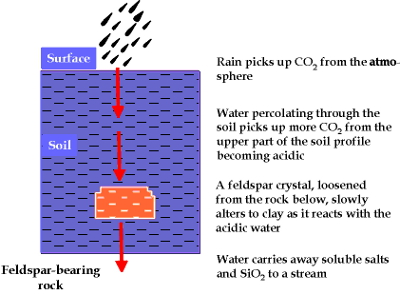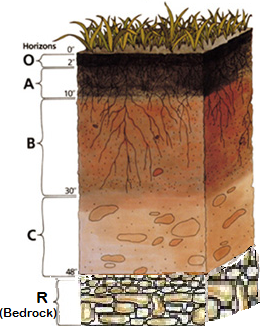
Soil formation
 The beginning of Life in the Soil
covers the abiotic (non-living) elements that create soil, generally at
a rate of about an inch every 500 to 1,000 years. The type
of soil that will be formed in an area is influenced by the type of
rocks involved, the topography of the site, climate, time, and living
organisms. Of these elements, the one I found most fascinating
involved the chemical reactions that occur in rocks to create soil.
The beginning of Life in the Soil
covers the abiotic (non-living) elements that create soil, generally at
a rate of about an inch every 500 to 1,000 years. The type
of soil that will be formed in an area is influenced by the type of
rocks involved, the topography of the site, climate, time, and living
organisms. Of these elements, the one I found most fascinating
involved the chemical reactions that occur in rocks to create soil.
For example, I hadn't
realized that clay and sand both have specific chemical formulas and are
created when feldspar (an abundant mineral in many rocks) reacts with
carbonic acid (formed from water and carbon dioxide). All
feldspars contain aluminum, oxygen, and silicon, and each also has one
of the following constituents: potassium, calcium, sodium, and  barium. When carbonic acid (H2CO3) and potassium-based feldspar (2K(AlSi3O8)) react and spit out clay (Al2Si2O5(OH)4) and sand (4SiO2), potassium carbonate is also formed. Perhaps this is why old soils are often excessively high in potassium?
barium. When carbonic acid (H2CO3) and potassium-based feldspar (2K(AlSi3O8)) react and spit out clay (Al2Si2O5(OH)4) and sand (4SiO2), potassium carbonate is also formed. Perhaps this is why old soils are often excessively high in potassium?
Another fascinating tidbit pertains to soil horizons.
If you've done any reading about soil, you probably know that natural
soils have a layer of partially-decomposed plant matter (the O layer),
beneath which is rich top soil (the A layer), then a small, pale E layer
out of which the organic matter, clay, and nutrients have leached,
followed by a slightly darker B layer. Nardi explained that the
textbook scenario is really only seen clearly in coniferous forests,
where toxic levels of iron and aluminum build up in the B layer and keep
most roots and soil life out. In deciduous forests, in contrast,
living things tend to mix the layers up, especially if earthworms have
been introduced.
Stay tuned for more on the soil "mixers" in tomorrow's post. In the meantime, you might want to check out my ebook for tips on taking a soil sample and learning more about your soil texture.
| This post is part of our Life in the Soil lunchtime series.
Read all of the entries: |
Want more in-depth information? Browse through our books.
Or explore more posts by date or by subject.
About us: Anna Hess and Mark Hamilton spent over a decade living self-sufficiently in the mountains of Virginia before moving north to start over from scratch in the foothills of Ohio. They've experimented with permaculture, no-till gardening, trailersteading, home-based microbusinesses and much more, writing about their adventures in both blogs and books.
Want to be notified when new comments are posted on this page? Click on the RSS button after you add a comment to subscribe to the comment feed, or simply check the box beside "email replies to me" while writing your comment.

Brian --- I'm glad to hear you like the nerdier posts --- I sometimes wonder if anyone reads those.
Your link didn't work for me, though --- I think I didn't have the right permissions. Do you mind sharing the authors and title so I can look it up?